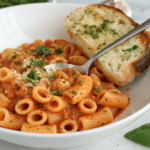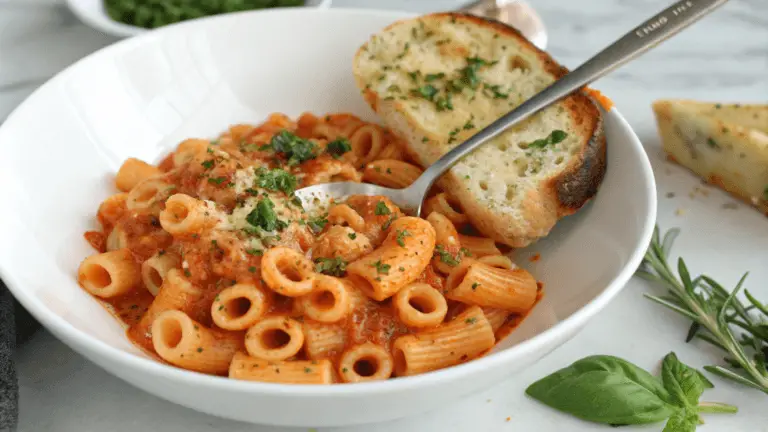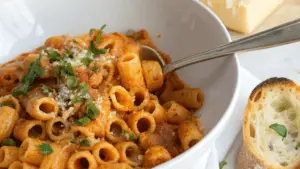Ditalini pasta, a small, tube-shaped pasta, has been a staple in Italian cuisine for generations. Its versatility and compact size make it a favorite for hearty soups, comforting casseroles, and delightful salads. In this article, we’ll dive into the wonders of ditalini pasta, uncover its origins, and explore creative ways to incorporate it into your meals. From its history to recipe inspirations, we’ll leave no stone unturned in celebrating this culinary gem.
The Origins of Ditalini Pasta
A Bite-Sized History of Ditalini
Ditalini, which translates to “little thimbles” in Italian, hails from Southern Italy, a region renowned for its rich culinary traditions. Its compact, tube-like structure was originally designed to complement the hearty soups and stews typical of the Mediterranean diet. This pasta type is cherished for its ability to hold sauces and flavors, making it a perfect addition to a wide variety of dishes.
The Role of Ditalini in Traditional Italian Cooking
In traditional Italian kitchens, ditalini pasta often plays the role of the unsung hero in iconic recipes like pasta e fagioli (pasta and beans) or minestrone. Its small size makes it ideal for spoonable dishes, allowing each bite to deliver a medley of flavors. Beyond soups, it’s frequently used in baked pasta dishes, blending seamlessly with creamy sauces and melted cheeses.
Why Ditalini Stands Out
One of the reasons ditalini is so popular is its unique shape and texture. Its hollow center captures just enough sauce, while its sturdy structure remains firm even after cooking. Whether you’re a pasta connoisseur or a culinary novice, ditalini offers a foolproof way to elevate your cooking. Plus, it pairs wonderfully with a variety of ingredients, from fresh vegetables to rich proteins.
Creative Ways to Cook with Ditalini Pasta
Ditalini in Hearty Soups
When it comes to soups, ditalini pasta is a superstar ingredient. Its small, tubular shape fits perfectly in broths and chowders, creating a satisfying texture in every spoonful. Classic recipes like pasta e fagioli and minestrone shine when you add this pasta. The hollow center absorbs just the right amount of broth, ensuring a flavorful bite every time. Try pairing it with vegetables, beans, and a sprinkle of Parmesan for a comforting bowl of goodness.
Salads with a Twist
Ditalini pasta is a game-changer in cold salads. Its compact size makes it easy to mix with fresh ingredients like cherry tomatoes, cucumbers, and olives. Toss it with a zesty Italian dressing or creamy mayo-based sauces to create a crowd-pleasing pasta salad. For an extra punch, add shredded chicken, crispy bacon, or tangy feta cheese. The pasta’s texture holds up well, keeping your salad fresh and flavorful.
Elevating Casseroles
Casseroles get an upgrade when you use ditalini pasta. Its structure blends beautifully with melted cheese, creamy sauces, and baked toppings. Imagine a cheesy ditalini bake with layers of mozzarella, marinara, and Italian sausage pure comfort on a plate. You can also experiment with healthier versions by adding roasted vegetables and lean proteins, making it a wholesome family dinner option.
Tips for Cooking Perfect Ditalini Pasta
Choosing the Right Cooking Method
Cooking ditalini pasta to perfection starts with boiling it in salted water. Use a large pot to allow the pasta to cook evenly and avoid sticking. Since ditalini is smaller than other pasta types, keep a close eye on the cooking time overcooking can lead to a mushy texture. Aim for al dente, where the pasta is firm yet tender.
Enhancing Flavors During Cooking
To enhance the flavor of ditalini pasta, consider adding a splash of olive oil or a bay leaf to the boiling water. For soups and casseroles, undercook the pasta slightly if it will continue cooking in the dish. This trick ensures it doesn’t turn overly soft during the final preparation.
Pairing Ingredients for Best Results
Ditalini’s adaptability makes it a star in any recipe, but pairing it with complementary ingredients can elevate your dish. For creamy dishes, choose cheeses like Parmesan or Gruyère. For lighter recipes, fresh herbs such as basil or parsley add a refreshing touch. No matter the recipe, the small size of ditalini ensures every bite is packed with flavor.
Delicious Recipes Featuring Ditalini Pasta
Classic Pasta e Fagioli
One of the most beloved recipes featuring ditalini pasta is the classic Italian soup, pasta e fagioli. This dish combines tender beans, rich tomato broth, and aromatic herbs with perfectly cooked ditalini. The result is a warm, comforting meal that’s both nutritious and satisfying. To make it your own, you can add pancetta for extra flavor or use vegetable broth for a vegetarian twist.
For more Italian-inspired recipes, check out Cajun Shrimp Pasta Recipe.
Cheesy Ditalini Bake
If you’re craving something indulgent, a cheesy ditalini bake is the way to go. This dish layers cooked ditalini pasta with béchamel sauce, shredded mozzarella, and grated Parmesan. Bake it until golden and bubbly for a delightful main course that’s sure to please. For added texture, sprinkle breadcrumbs mixed with Italian seasoning on top.
Light and Fresh Ditalini Salad
For a healthier option, try a light and fresh ditalini pasta salad. Toss the cooked pasta with chopped veggies, a handful of fresh herbs, and a tangy vinaigrette. Ingredients like cherry tomatoes, cucumbers, and olives create a medley of flavors, while ditalini’s small size ensures every bite is perfectly balanced.
Ditalini Pasta: A Pantry Staple for Endless Creativity
Why Ditalini Deserves a Spot in Your Pantry
Ditalini pasta isn’t just versatile; it’s also convenient. Its quick cooking time and ability to adapt to various cuisines make it a go-to ingredient for busy cooks. Whether you’re whipping up a last-minute soup or experimenting with a cold pasta salad, ditalini delivers both in taste and texture.
Quick Tips for Elevating Ditalini Dishes
- Experiment with sauces: From marinara to pesto, ditalini pairs wonderfully with nearly every type of sauce.
- Use it as a filler: Add it to stews, casseroles, or even creamy mac and cheese for a unique twist.
- Prep in advance: Cook a batch and store it in the fridge to save time during busy weeknights.
Final Thoughts on Ditalini Pasta
There’s no end to the creative possibilities with ditalini pasta. From hearty soups to baked dishes and salads, this petite pasta proves its worth in the kitchen. Whether you’re a seasoned chef or a beginner, ditalini is the perfect canvas for your culinary creations.
For more recipe ideas and tips, explore other delightful dishes on Larde Recipes.
Nutritional Benefits of Ditalini Pasta
A Balanced Source of Energy
Ditalini pasta, like other types of pasta, is a great source of carbohydrates, providing the energy your body needs to stay active. Whether you’re preparing a light pasta salad or a hearty casserole, ditalini makes a satisfying base for balanced meals. Pair it with lean proteins, fresh vegetables, and healthy fats for a nutritious, well-rounded dish.
Enriched with Essential Nutrients
Many brands of ditalini pasta are enriched with essential nutrients such as iron and B vitamins, supporting overall health. Iron helps maintain healthy blood circulation, while B vitamins boost energy and brain function. Choosing whole-grain ditalini adds fiber, aiding digestion and keeping you fuller for longer.
A Perfect Fit for Diet Variety
Ditalini’s small size makes it a fantastic option for portion control. It’s easy to incorporate into various diets, from vegetarian to low-sodium plans, by choosing appropriate ingredients. Whether you’re adding it to a broth-based soup or a protein-packed salad, ditalini pasta adapts beautifully to your nutritional needs.
How to Store and Use Leftover Ditalini Pasta
Proper Storage Tips for Ditalini Pasta
Storing ditalini pasta correctly can extend its shelf life and ensure it’s always ready for your next culinary creation. Keep uncooked pasta in a cool, dry place, ideally in an airtight container to prevent moisture and pests. Cooked ditalini should be stored in an airtight container in the refrigerator, where it will stay fresh for up to five days.
Creative Ways to Use Leftovers
Leftover ditalini pasta is a kitchen treasure, perfect for quick and easy meals. Toss it into a soup for added texture, or mix it with fresh veggies and a simple vinaigrette for an instant salad. If you’re in the mood for something indulgent, stir it into a creamy cheese sauce and bake it for a comforting pasta bake.
Reducing Food Waste with Ditalini
Ditalini pasta’s versatility makes it a great ally in reducing food waste. Leftover vegetables, roasted chicken, or even last night’s marinara sauce can find a new life when combined with cooked ditalini. Its neutral flavor complements almost any ingredient, making it an easy way to reinvent leftovers into delicious meals.
For more creative ideas and tips on pasta dishes, explore other recipes on Larde Recipes.
Common Mistakes to Avoid When Cooking Ditalini Pasta
Overcooking the Pasta
One of the most common mistakes when preparing ditalini pasta is overcooking it. Due to its small size, ditalini cooks quickly, often in less than 10 minutes. Leaving it on the stove for too long can result in a mushy texture that ruins the dish. Always follow the package instructions and check for that perfect al dente bite to avoid disappointment.
Skipping the Salted Water
Many home cooks skip the crucial step of salting their pasta water. This small step makes a huge difference in flavor. Because ditalini is often used in soups or salads, seasoning it while it cooks ensures a well-rounded taste, even before adding other ingredients. A generous pinch of salt in boiling water is all you need.
Forgetting to Rinse for Cold Dishes
If you’re using ditalini pasta in a salad or chilled dish, forgetting to rinse it under cold water can lead to clumping. Rinsing removes excess starch, which helps the pasta stay separate and easy to mix. However, avoid rinsing if you’re using it in hot dishes to keep the starch for better sauce adhesion.
Fun Facts and Lesser-Known Uses for Ditalini Pasta
A Pasta with Regional Variations
Did you know that ditalini pasta is sometimes referred to by other names across different regions of Italy? In some places, it’s called “tubettini,” highlighting its small, tube-like shape. These subtle differences add a touch of local charm to its universal appeal.
Beyond the Kitchen
While we mostly think of ditalini as a culinary staple, it has some surprising non-food uses too. Its small size and uniform shape make it a fun and safe craft material for kids. From pasta necklaces to art projects, ditalini offers a creative outlet beyond the dinner table.
A Popular Choice in Global Cuisine
Although ditalini pasta is rooted in Italian tradition, its use has expanded globally. It’s a key ingredient in Mexican sopa de fideo, and it often finds its way into American-style casseroles and chilled pasta salads. Its ability to adapt to diverse cuisines proves its versatility.
For more inspiration and recipes, explore Larde Recipes to discover dishes that showcase ditalini’s charm and adaptability.
Print
Ditalini pasta
- Prep Time: 10 minutes
- Cook Time: 20 minutes
- Total Time: 30 minutes
- Yield: 4 servings
- Category: Main Course, Side Dish, Salad, Soup
- Method: Boiling, Baking, Sautéing
- Cuisine: Italian
Ingredients
For Soups:
- Ditalini pasta
- Vegetable or chicken broth
- Diced tomatoes
- Cannellini beans or kidney beans
- Carrots, celery, and onions (mirepoix)
- Garlic
- Olive oil
- Fresh herbs (basil, parsley, thyme)
- Parmesan cheese
- Salt and pepper
- Pancetta or Italian sausage (optional)
For Pasta Salads:
- Ditalini pasta
- Cherry tomatoes
- Cucumbers
- Red onions
- Kalamata olives
- Feta cheese
- Italian vinaigrette or lemon dressing
- Fresh herbs (dill, parsley)
- Salt and pepper
- Grilled chicken, tuna, or chickpeas (optional)
For Bakes and Casseroles:
- Ditalini pasta
- Marinara or Alfredo sauce
- Mozzarella cheese
- Parmesan or Pecorino Romano cheese
- Italian sausage, ground beef, or shredded chicken
- Spinach or zucchini
- Garlic and onion
- Breadcrumbs mixed with Italian seasoning
- Olive oil
- Salt and pepper
Nutrition
- Serving Size: 1 cup cooked ditalini pasta (about 150g)
- Calories: 200
- Sugar: 1g
- Sodium: 10mg
- Fat: 1g
- Saturated Fat: 0.2g
- Unsaturated Fat: 0.8g
- Trans Fat: 0g
- Carbohydrates: 42g
- Fiber: 2g
- Protein: 7g
- Cholesterol: 0mg


